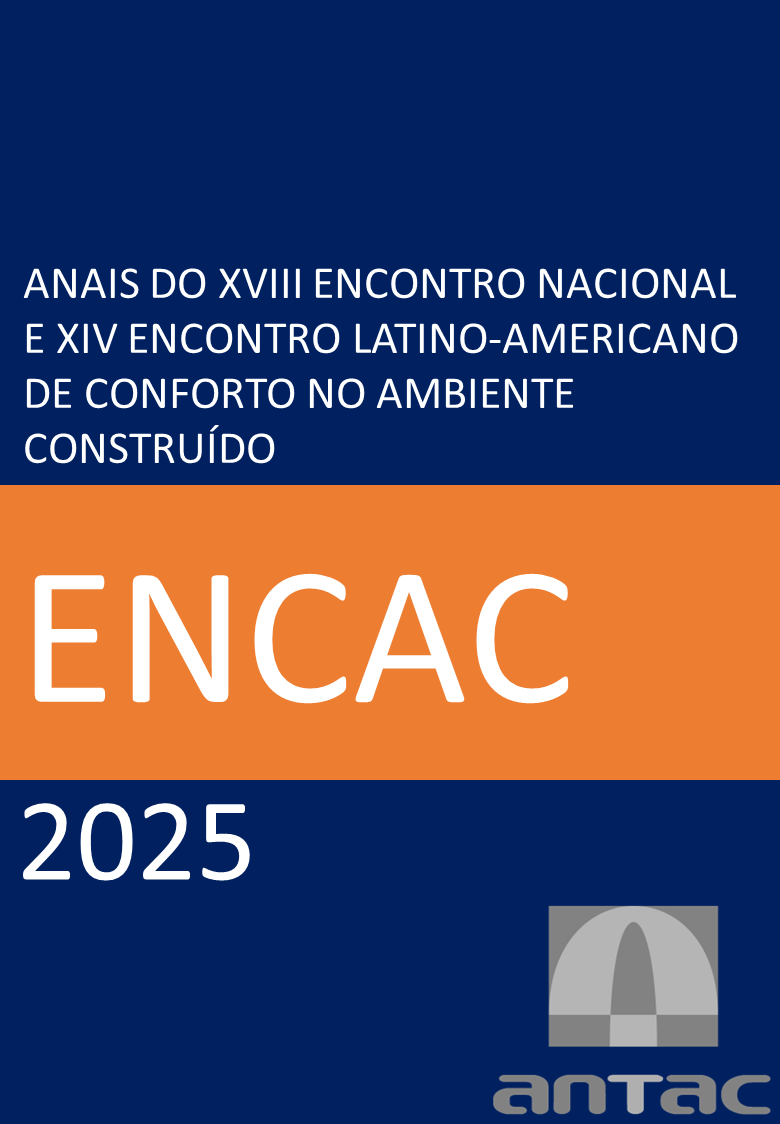DOI:
https://doi.org/10.46421/encacelacac.v18i1.6547Palavras-chave:
Qualidade do Ambiente Interno, Conforto, SaúdeResumo
Este artigo revisa as inter-relações entre a Qualidade do Ambiente Interno (QAI) e o bem-estar dos ocupantes, enfocando aspectos como conforto térmico, acústico, visual e qualidade do ar. Através da análise de 28 artigos revisados por pares na base de dados Scopus, a pesquisa identifica como essas variáveis influenciam a saúde e a satisfação dos usuários. Os resultados mostram que ambientes internos inadequados podem levar a problemas como a Síndrome do Edifício Doente e reduzir a produtividade. O estudo ressalta a importância de abordagens integradas que considerem medições objetivas e percepções subjetivas dos ocupantes, especialmente em habitações sociais, onde as condições frequentemente são substandard. A pesquisa contribui para o entendimento das dinâmicas entre QAI e bem-estar, sugerindo direções para futuras investigações e práticas de design que promovam ambientes mais saudáveis.
Referências
Alhorr, A., et al. (2016). “Indoor environmental quality and its impact on occupant satisfaction: A review.” Building and Environment, 109, 1-12. https://doi.org/10.1016/j.buildenv.2016.09.008
ASHRAE. (2021). “ASHRAE Standard 55: Thermal Environmental Conditions for Human Occupancy.” American Society of Heating, Refrigerating and Air-Conditioning Engineers. https://doi.org/10.21236/ADA598168
Brugge, D., et al. (2018). “Mold and respiratory health in children: A review.” Environmental Health Perspectives, 126(4), 047002. https://doi.org/10.1289/EHP2903
Coulby, J., et al. (2020). “A scoping review of technological approaches to environmental monitoring.” International Journal of Environmental Research and Public Health, 17(5), 1580. https://doi.org/10.3390/ijerph17051580
Diaz Lozano Patino, J., & Siegel, J. (2018). “Indoor environmental quality in social housing: A literature review.” Building and Environment, 132, 1-12. https://doi.org/10.1016/j.buildenv.2018.01.002
Fanger, P. O. (1970). “Thermal Comfort.” McGraw-Hill. https://doi.org/10.1016/0360-1323(70)90065-4
Fisk, W. J., & Rosenfeld, A. H. (2011). “Estimates of improved productivity and health from better indoor environments.” Indoor Air, 21(3), 206-218. https://doi.org/10.1111/j.1600-0668.2010.00745.x
Galasiu, A. D., & Veitch, J. A. (2006). “Indoor environmental quality and occupant satisfaction: A review.” Lighting Research & Technology, 38(3), 167-185. https://doi.org/10.1191/1477153506li143oa
Jensen, K. L., & Arens, E. A. (2005). “Acoustic comfort in offices: A review of the literature.” Indoor Air, 15(3), 182-189. https://doi.org/10.1111/j.1600-0668.2005.00337.x
Kang, J., et al. (2017). “The impact of artificial lighting on the performance and well-being of occupants.” Lighting Research & Technology, 49(2), 159-174. https://doi.org/10.1177/1477153516636930
Kim, J., & De Dear, R. (2012). “Thermal comfort and productivity in office environments.” Building and Environment, 57, 1-10. https://doi.org/10.1016/j.buildenv.2012.04.009
Lee, J., et al. (2015). “The effects of noise on health and productivity: A review.” Facilities, 33(3/4), 164-178. https://doi.org/10.1108/F-03-2014-0034
Logue, J. M., et al. (2018). “Indoor air quality and health: A review.” Environmental Health Perspectives, 126(4), 047002. https://doi.org/10.1289/EHP2903
Mannan, M. S., & Al-Ghamdi, S. G. (2021). “Indoor air quality and its impact on health: A review.” Environmental Science and Pollution Research, 28(30), 40571-40584. https://doi.org/10.1007/s11356-021-13454-9
Mark, D., & Wang, Z. (2015). “The effects of noise on health and productivity.” Journal of Environmental Psychology, 43, 1-8. https://doi.org/10.1016/j.jenvp.2015.04.001
Mewomo, M., et al. (2023). “Synthesis of critical factors influencing indoor environmental quality and their impacts on building occupants’ health and productivity.” Journal of Engineering, Design and Technology, 21(4), 123-145. https://doi.org/10.1108/JEDT-05-2022-0247
Mujan, M., et al. (2019). “Acoustic comfort in buildings: A review.” Facilities, 37(7/8), 421-432. https://doi.org/10.1108/F-05-2018-0055
Quang, N. T., et al. (2014). “Thermal comfort: A review of the literature.” Energy and Buildings, 78, 23-34. https://doi.org/10.1016/j.enbuild.2014.03.022
Seppanen, O., et al. (2004). “Impact of temperature on productivity.” Indoor Air, 14(1), 1-20. https://doi.org/10.1111/j.1600-0668.2004.00223.x
Šujanová, J., et al. (2019). “A healthy, energy-efficient and comfortable indoor environment: A review.” Energies, 12(21), 4091. https://doi.org/10.3390/en12214091
Van Duijnhoven, J., et al. (2019). “The impact of daylight on health and performance.” Building and Environment, 163, 106-115. https://doi.org/10.1016/j.buildenv.2019.106335
Wang, Z., et al. (2021). “Acoustic comfort in buildings: A review.” Building and Environment, 186, 107318. https://doi.org/10.1016/j.buildenv.2020.107318
Wong, N. H., Mui, K. W., & Tsang, H. W. (2018). “An open acceptance model for indoor environmental quality (IEQ).” Building and Environment, 144, 112-121. https://doi.org/10.1016/j.buildenv.2018.07.008
Zota, A. R., et al. (2018). “Indoor air quality in low-income housing: A review.” Environmental Health Perspectives, 126(4), 047002. https://doi.org/10.1289/EHP2903
Zhang, M., Mui, K. W., & Wong, N. H. (2023). “Indoor environmental quality: A review of the literature.” Building and Environment, 207, 108-118. https://doi.org/10.1016/j.buildenv.2021.108118
Zhao, Y., & Li, Y. (2023). “Multi-domain indoor environmental quality in buildings: A review of their interaction and combined effects on occupant satisfaction.” Building and Environment, 227, 109-120. https://doi.org/10.1016/j.buildenv.2023.109120

